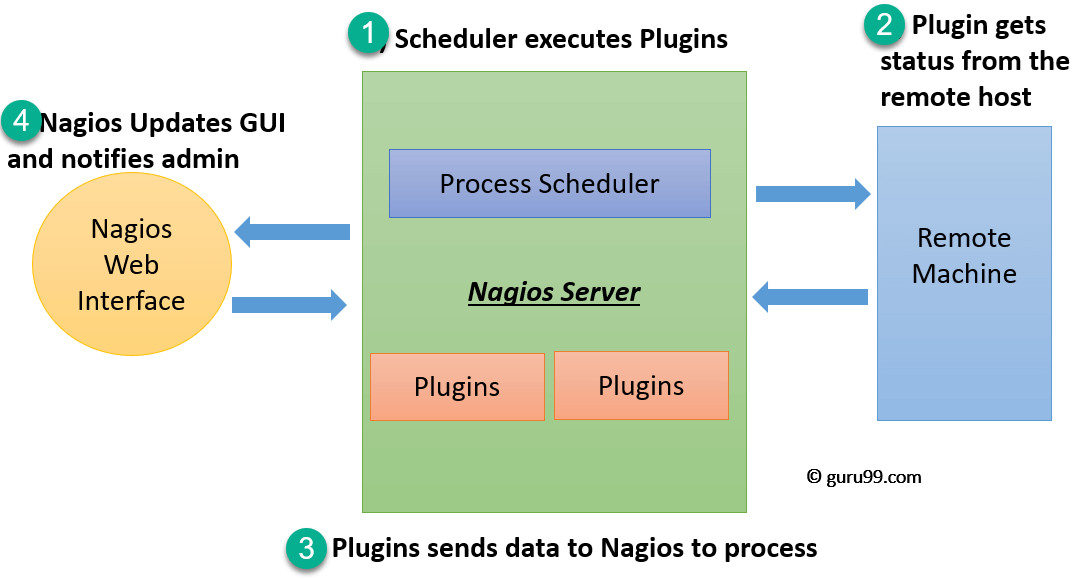
———————————-
NAGIOS MONITORING SERVER SETUP
———————————-
PRE-REQUISITE:-
==============
1. install nagios on linux system
2. run as root
3. put nagios user in visudo
4. disable selinux
5. flush iptables
INSTALLATION:-
=============
(I)
1. install the following dependent packages
# yum install -y httpd php gcc glibc glibc-common gd gd-devel make net-snmp openssl-devel xinetd
2. To check whether they installed or not
# which httpd (or) # which php
3. Create nagios user
# useradd nagios
4. Assign password to nagios user
# passwd nagios
5. Create a group called nagcmd
# groupadd nagcmd
6. Add apache user and nagios user to nagcmd group
# usermod -G nagcmd nagios
# usermod -G nagcmd apache
7. Create a directory called nagios under root
# mkdir /root/nagios
# cd /root/nagios
(II)
1. Download nagios core files and nagios plugin files
# wget wget https://assets.nagios.com/downloads/nagioscore/releases/nagios-4.3.4.tar.gz
2. Extract the nagios core files
# tar -xvf nagios-4.3.4.tar.gz
3. Navigate to nagios core file
#cd nagios-4.3.4
4. Configure nagios core
# ./configure –with-command-group=nagcmd
5. Compile & install binaries
# make all
# make install
# make install-sh
6. Install init scripts for nagios
# make install-init
7. Install nagios command line
# make install-commandmode
8. Install nagios configurations
# make install-config
9. Install nagios web configuration
# make install-webconf
10. Create an account for logging nagios web page and accessing application
# htpasswd -b -c /usr/local/nagios/etc/htpasswd.users nagiosadmin nagiosadmin
11. Restart the httpd services
# service httpd restart
(III)
1. Go to /root/nagios directory & install nagios plugin file
# cd /root/nagios
# wget https://nagios-plugins.org/download/nagios-plugins-2.2.1.tar.gz
2. unzip the tar file
# tar -xvf nagios-plugins-2.2.1.tar.gz
3. Go to nagios directory and navigate to nagios-plugin directory
# cd nagios-plugins-2.2.1/
4. Compile and install nagios plugin
# ./configure –with-nagios-user=nagios –with-nagios-group=nagios
# make
# make install
(IV)
1. go to /root/nagios and install nrpe plugin
# wget https://github.com/NagiosEnterprises/nrpe/releases/download/nrpe-3.2.1/nrpe-3.2.1.tar.gz
2. unzip the tar file
# tar -zxvf nrpe-3.2.1.tar.gz
3. navigate to nrpe directory
# cd nrpe-3.2.1/
4. compile and install nrpe plugin
# ./configure
# make all
# make install
# make install-xinetd
# make install-daemon-config
5. modify the changes
# vi /etc/xinetd.d/nrpe
———————————————
only_from = 127.0.0.1 nagios-server-ip
————————————————-
6. restart xinetd services
# service xinetd restart
7. install a check_nrpe directory
# ls -l /usr/local/nagios/libexec/check_nrpe
(V)
1. configure nagios
# vi /usr/local/nagios/etc/nagios.cfg
—————————————————–
uncomment following line
# cfg_dir=/usr/local/nagios/etc/servers
—————————————————–
2. create a directory
# mkdir /usr/local/nagios/etc/servers
3. configure nagios contact
# vi /usr/local/nagios/etc/objects/contacts.cfg
4. configure check_nrpe command
# vi /usr/local/nagios/etc/objects/commands.cfg
——————————————————-
define command {
command_name check_nrpe
command_line $USER1$/check_nrpe -H $HOSTADDRESS$ -c $ARG1$
}
————————————————————
(VI)
1. Verify nagios configuration files to find whether we have done anything wrong in config files
# /usr/local/nagios/bin/nagios -v /usr/local/nagios/etc/nagios.cfg
2. Start nagios services
# service nagios start
3. make services permanent
# chkconfig nagios on
# chkconfig httpd on
4. Now go to browser and hit ipaddress/nagios
http://ipaddress/nagios
5. enter credentials
—————————|NAGIOS CLIENT/AGENT SETUP|—————————
1. enable epel repo
# yum install -y epel-release
2. now install nagios and nrpe plugins
# yum install nrpe nagios-plugins-all
3. update nrpe config file
# vi /etc/nagios/nrpe.cfg
—————————————–
allowed_hosts=127.0.0.1,nagios-server-ip
—————————————–
4. restart the services
# systemctl start nrpe.service
# systemctl enable nrpe.service
———————————-|NAGIOS INSTALLATION VERIFICATION|—————————–
1. now come to nagios server and execute following command to check nrpe daemon is running correctly or not
# /usr/local/nagios/libexec/check_nrpe -H nagiosclieintip 0/P:- NRPE 3.0
2. define your own host.cfg file, service.cfg file and add nrpe defnition in commands.cfg and update these entries in nagios.cfg
3. after you always modify the config files execute nagios verication command
# /usr/local/nagios/bin/nagios -v /usr/local/nagios/etc/nagios.cfg
4. restart nagios
# service nagios restart
Recent Comments